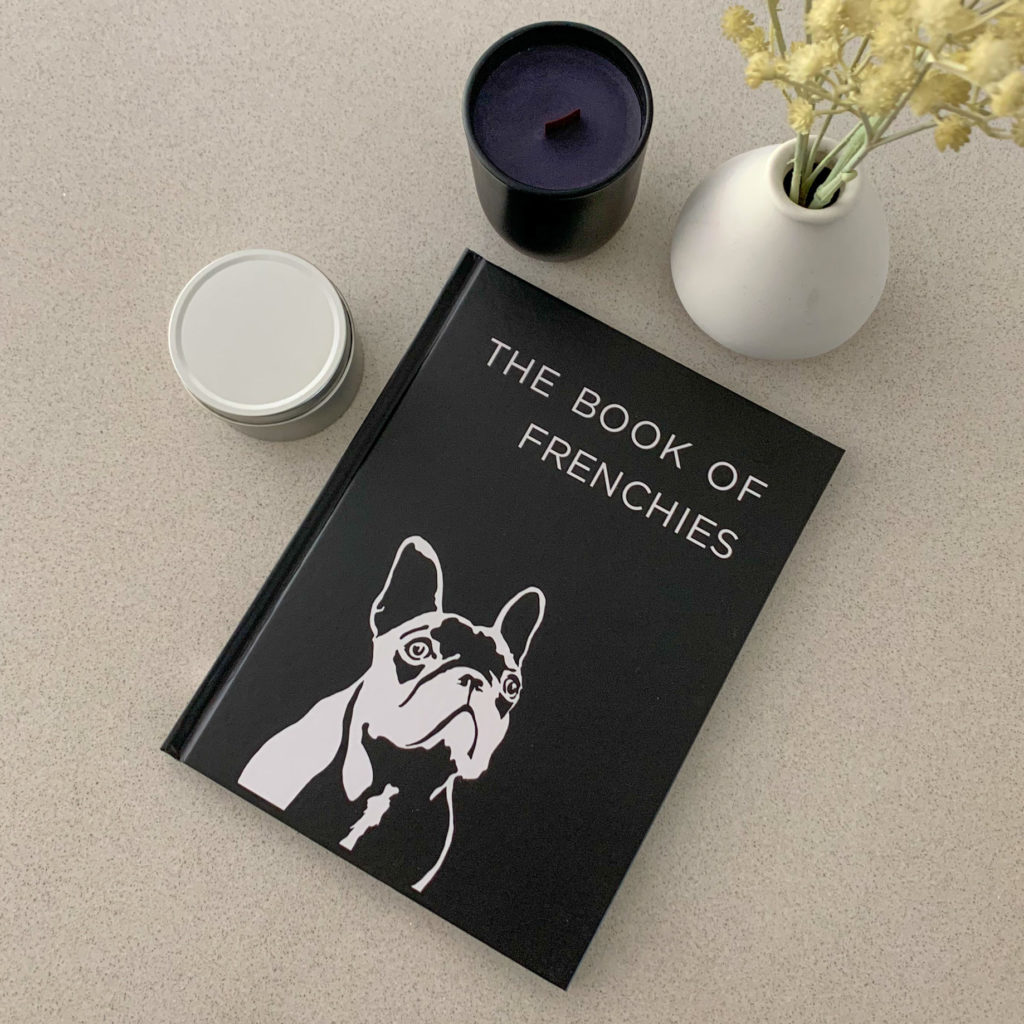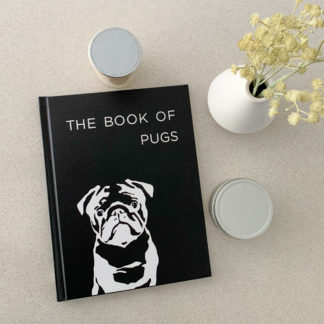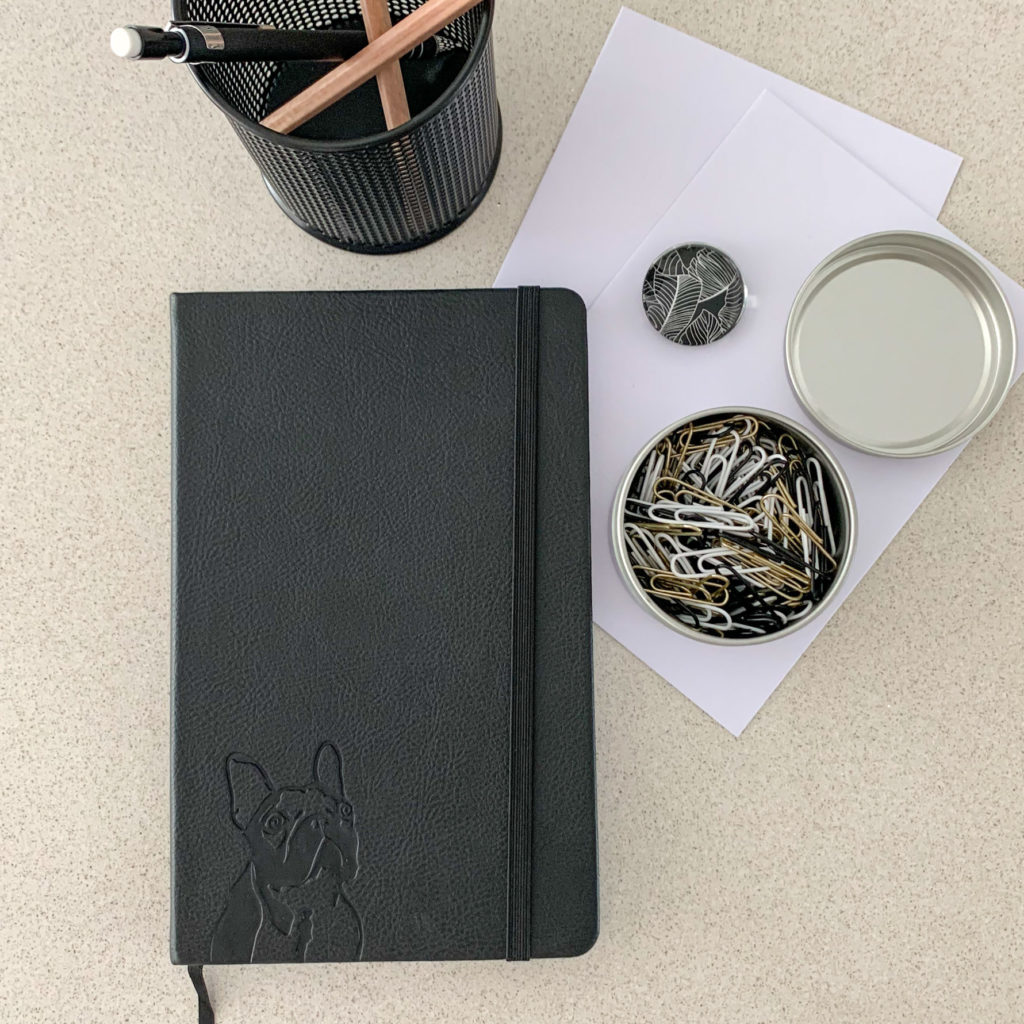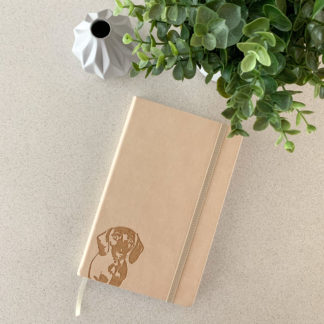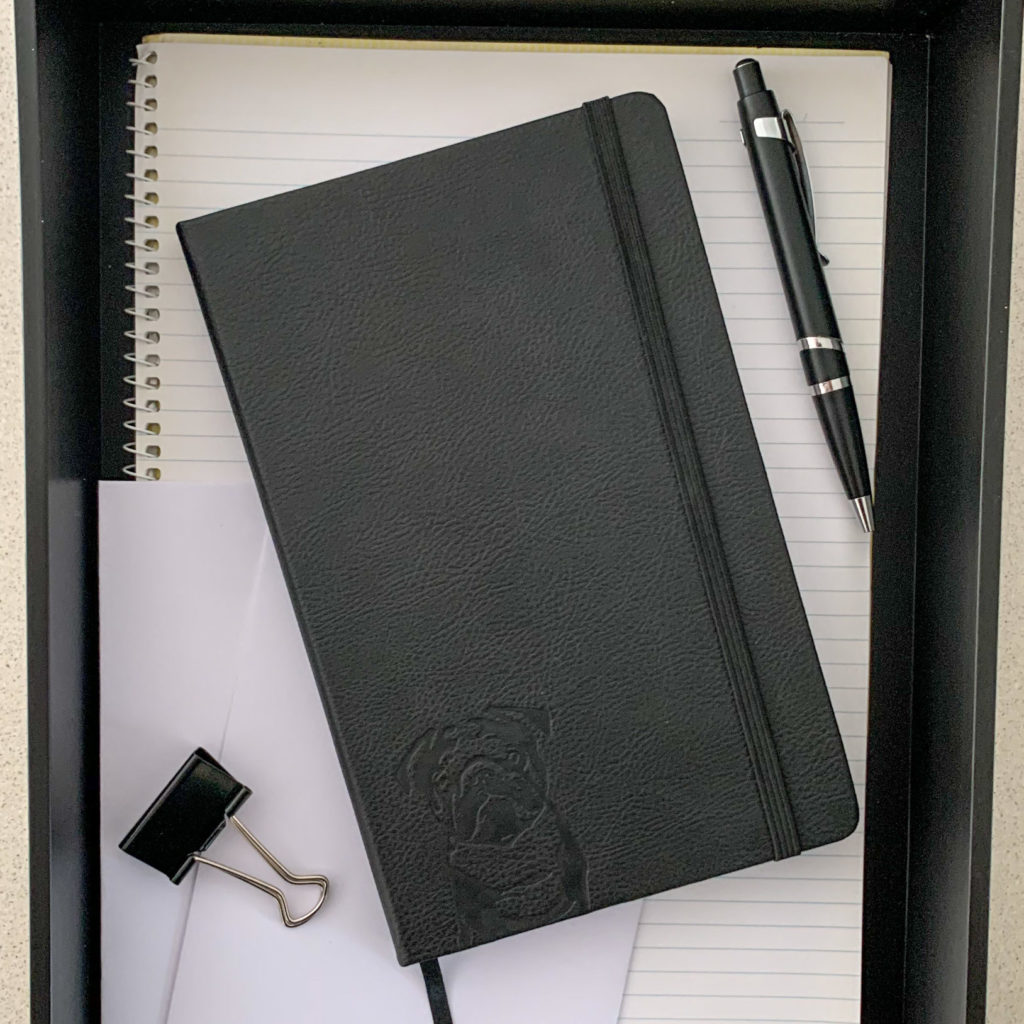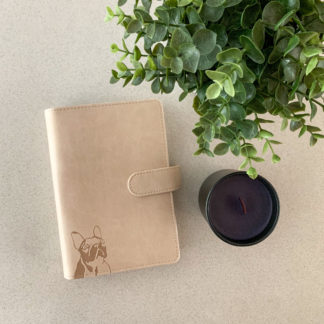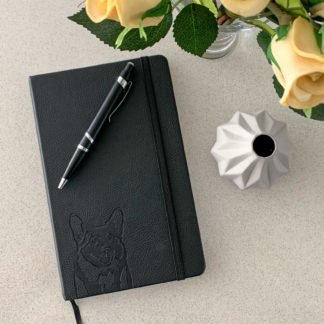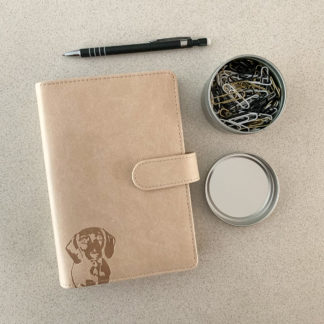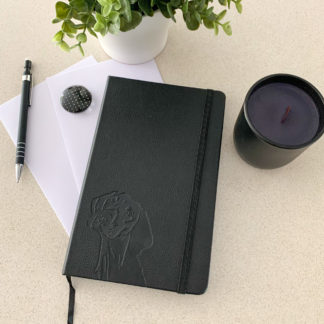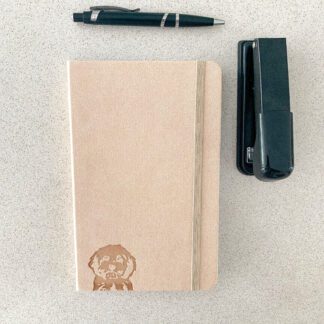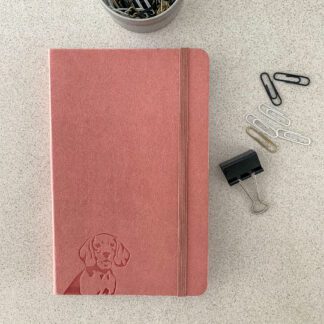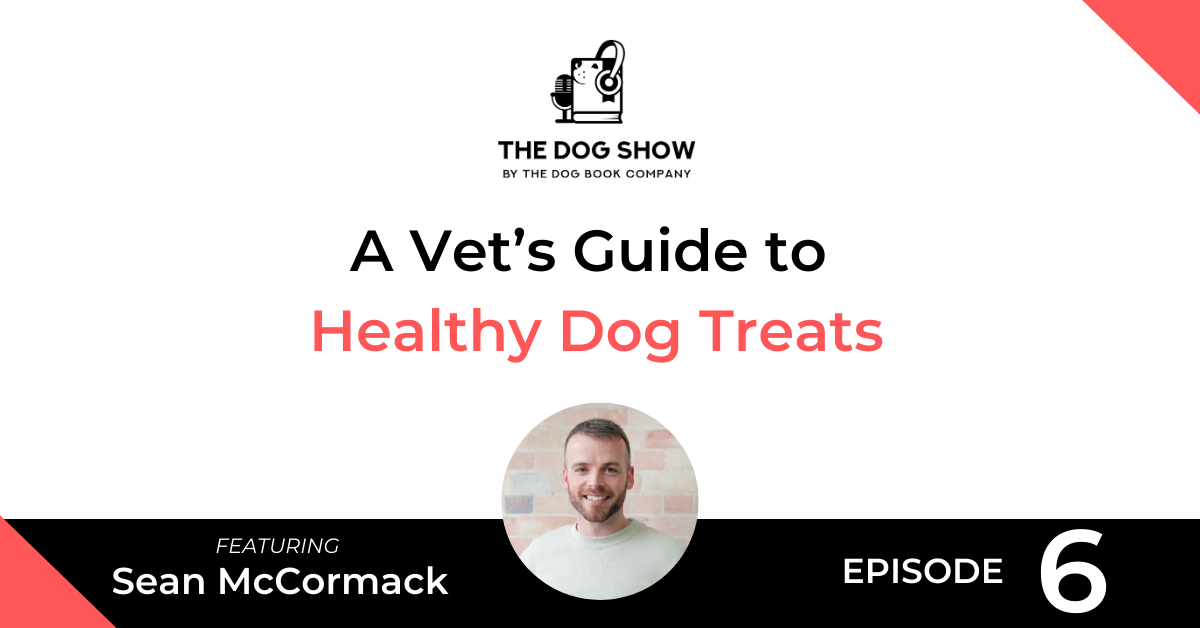
Are you on the lookout for healthy dog treats to feed your best friend?
If so, this episode of The Dog Show featuring Sean McCormack is a must-listen.
Sean is the Head Vet at Tails.com, a dog food delivery service in the UK, Germany, and France that tailors recipes and portions for every owner.
Sean’s also the co-author of The Happy Dog Cookbook, a wildlife conservationist, a podcast host, and has a unique interest in exotic animals.
In the interview, we discuss Sean’s history with animals, the importance of healthy dog treats, and delve into a research study about why dogs make us so happy.
Find out more about Sean at these links:
- Tails.com
- Tails on YouTube
- The Dog Difference Report
- The Happy Dog Cookbook
- Ealing Wildlife Group
- Ealing Wildlife Group on YouTube
- Sean’s Podcast
- Sean on Instagram
- Dr. Sean McCormack (Coming Soon)
Listen
Watch
Read
Will: In this episode, I interview Sean McCormack. Sean’s the head vet at tails.com, a dog food delivery service in the U.K., Germany, and France, that tailors recipes and portions for every owner. He’s also the co-author of “The Happy Dog Cookbook,” a wildlife conservationist, a podcast host, and has a unique interest in exotic animals. We’ll talk about Sean’s history with animals, the importance of healthy dog treats, and delve into a research study about why dogs make us so happy. Sean, thanks so much for coming on the podcast today, “The Dog Show.”
Sean: Yeah, thanks for having me. It’s great to be here.
Will: Yeah, really good to have you. So, let’s start with something nice and simple. I just want to hear a bit of a history about like what you’ve done with dogs in the past, whether you’ve got a dog currently, just share a little bit about your history with dogs.
Sean: Yeah, so I I’m a massive dog person. I don’t have a dog currently, sadly. I was thinking this would be the year that I get a dog again. But grew up with dogs all my life. I’m a bit of a terrier man. We’ve always had terriers and little small mixed breeds, but yeah, just a big dog fan all my life. I wanted to be a vet all my life as well and not anti-cat, but definitely a dog bias if I had to choose one. But yeah, this year I was thinking of getting a dog and last year I had five weddings and lots of travel back to Ireland. And I was in Australia as well earlier in the year. And I thought when I came back was probably a good time to start looking, but then we’ve gone into lockdown now. So, it’s not the best time maybe. But watch this space. I think there’s a dog in my near future. I’m very, very broody at the moment for a dog.
Will: Well, it’s interesting you say that, I guess you could look at lockdown in another way. It’s a good time to spend a lot of time with a puppy or a young dog.
Sean: Yeah, it is. I mean, I keep saying, I get asked this question a lot, you know, at the moment, you know, is it a good time to get a puppy? And that I think if you weren’t already like seriously considering it and prepared for one, it’s probably not the best time to make that decision now just because we’ve got this time at home because there can be problems on the other side, you know, when life does go back to normal. It’s also quite difficult at the moment to socialize the puppy about normal life when we’re social distancing and things like that. So, there’s pros and cons. And I think my advice has to be, you know, if you weren’t really on the brink of getting one and prepared to get a dog at this point in time, now lockdown shouldn’t be kind of like the excuse you need.
Will: Yeah. Fair enough. I guess that’s probably a good rationale in general anyway. A lot of people rush into getting dogs and they don’t realize how big a responsibility it is.
Sean: Yeah, absolutely. Like we were saying, you know, dogs are for life, not just for lockdown.
Will: Yeah. That’s a good sign. Yeah. I’ve not heard that one yet, but I’ll be using it now.
Sean: Yeah, have you got a dog yourself, Will?
Will: I do. Yeah. I have a French bulldog.
Sean: Oh, yeah. We talked about [inaudible 00:03:23].
Will: We spoke about this the other week. Yeah,
Sean: Yeah. Good stuff. Keeps you on your toes, yeah?
Will: She does. She’s probably enjoying lockdown. She’s got a lot more stimulation, but, you know, she’s four years old now, so she’s kind of been through the whole journey of us being away from her and all that kind of stuff. So…
Sean: Yeah, she’d grown out of most of her annoying puppy habits, has she?
Will: Not really. Not yet.
Sean: No? Frenchie’s kind of retain that quite a while, don’t they?
Will: We are waiting for it though.
Sean: They don’t settle down until they’re 10.
Will: Yeah. We’re waiting for it to, you know, move beyond the puppy stage, but it doesn’t seem to be happening. So, anyway.
Sean: My last dog was a bit of a permanent puppy, not the brightest dog, a bit frustrating at times, but she’s a little sweetie.
Will: What is it about terriers that you like? Is there something about the breed that’s unique or interesting that you haven’t…like most people don’t know about or…?
Sean: I think people tend to gravitate towards the dogs they first had or that they grew up around. So, it was just my dad’s decision. My elder sister was afraid of dogs as a child. Might have rubbed off on my mom a little bit. And I think it was just circumstance that one of my dad’s colleague’s family had a terrier that got into a little dalliance with one of the village dogs, let’s say, and had an accidental litter. And then my dad just brought one home. So, we just grew up with terriers. And then I brought another one into the home later on and, I guess, I warmed to them. And then you become, I think, a bit biased towards the type of dog you grew up around.
I just love their energy. I think they’re a good all-rounder. I liked their size as well. I think like, you know, it’s quite easy to have a small dog. They are definitely more portable and people warm to them and people will kind of look after them for you if you’re going away and things maybe more so than the bigger dog, but I just like terriers have like all the kind of pros of a small dog, but they’re still feisty and they’re fun and they’re stubborn and they, like, have their own little minds and they’re quite mischievous as well. So, that’s what I like about them.
Will: I’ve heard in the past that like Jack Russell terriers, for example, have a tendency to run away more than other dogs. Is that an urban myth or is that true or…?
Sean: I wouldn’t say run away more. I think they’re definitely a bit harder to train because terriers are quite, like, willful and strong-minded, some would say stubborn. So, you just need to understand them a bit. And I think they’re definitely not a beginner’s dog, you know, they are quite challenging, I think, to train and to have well. So, some people might struggle with kind of training them for recall and keeping their attention and things. They’re into everything and they’re quite strong-willed.
Will: Okay. Do they have any unique health issues?
Sean: Most pedigree breeds…I do like as a vet about the terrier group is as a group, they have less, kind of, predisposed health conditions. They tend to be one of the groups of dogs that are maybe more close to the time when we bred them purely for function and they needed to work and they needed to be healthy and strong and really thrive at doing what they do best. So, they’re not too far removed from the kind of old working lines that, you know, if they did have health problems, they wouldn’t really be bred from.
Some of the other groups, you know, kind of like toy dogs and utility breeds and things like that, that kind of have come a long way from their original function and are more…the population is more bred now for, kind of, appearance in the show ring and things like that. Those are the kinds of breeds maybe where we’ve gone a bit too far towards appearance over function or health. So, I think that one of the good things that I like about terriers is they are still very much fit for function and quite a healthy group when we talk about, kind of, genetic health problems.
Will: Yeah. That’s good.
Sean: Yeah. I saw a stat recently actually that, if I have to choose a pedigree breed…I’m a big fan of crossbreeds. But if I had to choose a pedigree, it probably be a border terrier. And I saw a stat that actually border terriers were the most popular breed of dog with vets in the U.K. And one of the reasons was they’re not prone to too many health problems.
Will: Yeah. Well, I guess you’re exposed to all those different things that, you know, the average dog owner or a new dog owner wouldn’t know about. So, you can make an educated decision. Yeah.
Sean: Yeah, exactly. And it is frustrating sometimes to see, you know, a family coming in with their brand new puppy and it’s a breed that you’re kind of cynically, but through experience kind of thinking, “Oh, this dog’s going to have these problems,” and you’re just listing them off. You know, we do have an issue with kind of pedigree dog health. Yeah. That’s another topic for another day, I think.
Will: Yeah. I think so. It’s interesting though, as a French bulldog owner, I think you walk into the vet and I don’t know whether it’s just in my head, but it looks like they’ve got the dollar signs in their eyes already when you’re walking in, like…
Sean: Yeah. I hate to hear that because vets don’t get into it for the money. Let me tell you that. Yeah.
Will: Yeah. [inaudible 00:08:04]
Sean: Although the bill, you know, seems high to provide medical care to your pet, you know, vets get into it for the love of dogs. Love of animals, really. So, I think most vets are thinking when we see some kind of brachycephalic dogs coming in, or other breeds that have inherent health issues related to how they’re bred is, “Oh, I really hope this one’s going to be okay.” Rather than we don’t want to see a dog coming back 20 times a year for issues that could have been prevented with better breeding. So, I hope you’ve got a healthy one.
Will: Yeah. Well, sometimes.
Sean: She’s cost you a few dollars over the years, has she?
Will: Yeah. Her main issues are allergy-related. So she has…which initially I thought, you know, allergies might be an isolated kind of thing, which caused one set of symptoms, but it turns out allergies cause so many different types of symptoms, which…
Sean: Lots. Yeah. Does she have digestive issues or skin issues or both?
Will: Both.
Sean: Both.
Will: Yeah. So, she’s like…we cook her food. So, it’s a really strict diet, which we’ve got under control now. She doesn’t really have any digestive issues anymore. I mean, she can’t have any extras or anything though, as soon as she has something which is off the main diet, then it’s no good.
Sean: Yeah. Gets a bit whiffy, does it?
Will: That’s probably the best of it.
Sean: Oh no.
Will: The skin allergies, I think are more related to the environment, which are much harder to look after.
Sean: Like pollens and things like that in the environment, yeah. Does it flare-up in the summertime?
Will: Yeah. Usually, change of seasons. So at the moment, it’s quite bad because we’re going into winter from summer. Yeah. But we’ve got drugs to kind of manage it and, you know, we’ve got processes in place for like cleaning regularly and all this kind of stuff. But yeah. I mean, it’s a lot of work because like anyone I talk to, I just think you got to be aware of these things, but obviously, once you love a dog and you’ll do anything for them, right? So…
Sean: Totally. Yeah. And I think those are the kind of invisible things that you don’t necessarily think about. So like, you know, bulldogs are quite prone to, kind of, immune disorders and allergies and things like that as well. But what everyone thinks about when they’re getting a bulldog and thinking about health is, you know, breathing and eyes and skin rolls and things like that, but internal problems as well. Yeah. And I think people just aren’t prepared for it. They might, you know, you read…if you were researching a dog breed and, you know, you’re thinking like I’m set on this or I’m set on that, you’ll read lots and lots of information and kind of like the health issues are mentioned where you’re reading, but you kind of don’t take on board naturally like this is a very real risk or this is something that we’re probably going to face and what the consequences are until you’re in it really.
Will: Yeah. It’s hard to know. I mean, I guess everyone’s probably susceptible to getting, you know, blinders on at some point when they want to do something, right? So…
Sean: Yeah. I’ll get one anyway, it’ll be fine, I’ll get pet insurance.
Will: Well, that’s one thing I would absolutely recommend. So, we chose not to get pet insurance at the beginning. And then once you have any pre-existing conditions, you’re not covered. So…
Sean: Yeah, I’m a big fan, unless you can put away like a similar amount into your own little, you know, dog pot in case something happens, I think it’s just a good policy to try and get good insurance cover. You just never know when something’s going to go wrong. And then as you say, if it’s pre-existing, you’re not going to be covered in the future. So…
Will: Okay. Let’s go down a different path. This is something I’m really interested to ask you about. I understand you’ve got an interest in exotic animals. Now, a French Bulldog’s not an exotic animal, obviously. But, you know, funnily enough, I didn’t really think of the term exotic animal a lot until more recently when I was watching “Tiger King” on Netflix. And, you know, there’s lots of horrible things about that documentary, but it’s, you know, quite enthralling and interesting to watch. But what is it about exotic animals that you like and talk to me about the type of animals that we’re talking about here.
Sean: Yeah. So, technically…people laugh when I explain this to them, technically in veterinary medicine, an exotic is anything that’s not a dog or a cat that people keep as a pet. So, it can be at as banal as a rabbit or a guinea pig or a gerbil right up to, you know, primates and exotic birds, parrots, reptiles, things like that, fish. They’re all under the umbrella of exotics. For me, I think like before I was ever kind of destined to be a vet, I was a total nature nerd, like wildlife geek. I was always interested in bugs and turning over stones and kind of looking at frogs and ponds and stuff like that. So, anything that kind of like cracked or kind of slimed or had scales or things like that really fascinated me. So, I was quite interested in the little things like reptiles and amphibians in particular, birds as well.
So then when I became a vet, I just realized during my studies actually that I had a lot more knowledge about a broader range of animals than just our domestic pets. I did an animal science degree before my veterinary degree. So, did veterinary as a graduate and yeah, just realized actually the veterinary training in itself and the kind of average vet student didn’t really know as much as I did about those things like reptiles, amphibians, birds, exotic mammals, and stuff. So, I kind of tailored the final stages of my studies towards zoo and wildlife medicine. I did a few elective modules on that. And then in my first practice after graduation, I was very lucky to get into a practice which had five zoo or wildlife collections on their books. And we also saw a lot of wildlife for, kind of, rehabilitation and wildlife medicine.
So, I just started with a very, very broad base of like lots and lots of different species. And I was very lucky to work with amazing species like elephants and kind of some big cats, quite exotic birds and reptiles as well. And then in, kind of, my, kind of, subsequent clinical career, set up an exotic service in some kind of traditional neighborhood practices where I saw mainly reptiles and birds alongside the kind of dogs, cats, rabbits side. So, I loved the diversity of it and I love as well being like a true biologist at heart. I just loved the kind of the evolutionary kind of characteristics of all these different groups and how they’re adapted to their environment and things like that and how, you know, it’s quite an art and a skill to be able to keep and breed these animals well.
But I think over my journey of kind of like the six years I was in clinical practice, I started to get a little bit jaded in a way about actually some of these species that people are keeping as pets in captivity, either are not suited to be in captivity or you really, really need to know your stuff to be able to keep them well. And I don’t really agree that like anyone can just go out and buy some of these animals for a hobby. I think there’s big problems in that because ultimately, if you don’t know your stuff or you haven’t done your research or you’re skimping on their care, the animal suffers in the end. So, it’s a contentious topic.
I think, you know, certain animals like, you know, kids keeping a corn snake or a leopard gecko as a pet, you know, for 15, 20 years, brilliant pet, easy to keep, you know, fascinating animal and their needs can be met in captivity, but things like very sociable parrots being kept in a small cage in someone’s living room, or don’t get me started on the exotic cat thing, you know, in the States that’s just ludicrous that that’s allowed to go on. Actually, when I was in Australia earlier this year, you know, it really struck me just seeing cockatoos flying around in, you know, family groups or social groups. And then from my perspective as a vet, you know, dealing with kind of avian medicine, seeing the same species on its own in a cage with a human family didn’t sit very comfortably with me.
Will: Yeah. I guess I take that for granted. I’m so used to seeing cockatoos in herds all the time…or not herds, what do they call them?
Sean: Free, right? Flocks.
Will: Flocks. There we go. So, when you were traveling around, was that a part of the journey seeing different exotic animals and kind of learning more about different exotic animals in different areas or…?
Sean: In Australia?
Will: Yeah.
Sean: Yeah. As I said, I’m a big wildlife geek. I’m a bit of a birdwatcher. Not, you know, one of these crazy ones that travels everywhere and keeps a list and that, but I’m interested in nature. So whenever I’m on holiday, I try and get out into the wilderness and explore and get my camera and take some snaps and get my mind off the stresses of daily life and work life. And part of that is just going and exploring wildlife. But I love Australian wildlife because a lot of your creatures are just so bizarre in terms of their behavior and their biology and things. So, I’ve had great encounters with, you know, [inaudible 00:16:36] and kangaroos and lots of birds, but my nemesis now is a platypus. I’ve been three times and I’ve tried to see them, but I’ve never managed it. Yeah.
Will: Okay. Yeah. They’re a strange-looking animal again, I guess they’re, you know…all of them have some sort of heritage. But yeah, Australia is unique with a lot of different animals, I guess because we’re so isolated.
Sean: That’s it. And yeah, marsupials, like, are kind of unique in the world really and you’ve got a lot of those.
Will: So, you’re not going to be the next [inaudible 00:17:08] if you’re not, you know, taking lists and monitoring behavior and things like that.
Sean: I’ll never rule it out. I mean, you know, he’s an absolute legend. I’ve met him twice actually, and he’s an absolute legend and an inspiration. I would love to get into, kind of, wildlife presenting and things that I run my own wildlife group where I live. So, we do a lot of practical conservation work and yeah, we submit data and we look after and monitor some pretty threatened species over here. So yeah, never say never, you know, it could be a position coming up there in the next few years.
Will: Yeah. Maybe. I mean, the world is your oyster, though, right with the way, you know, technology and stuff these days. So…
Sean: That’s it. And I do, kind of, make YouTube videos and try and do a bit of educational, kind of, wildlife biodiversity stuff through that group and through my own social media and stuff as well. So yeah, wildlife, I think, is my first passion, veterinary medicine came a lot later than that.
Will: Okay. So, let’s jump in to talk about your book. So, you’re the co-author of “The Happy Dog Cookbook,” and it’s a recipe book basically for dog owners to make home-cooked treats that are happy…Oh, there we go. Perfect.
Sean: I’ve got a copy here. Yeah.
Will: Great. So, what was the inspiration for the book, just quickly?
Sean: Yeah. So as I say, I did animal science before my veterinary degree and a big part of that is nutrition of a wide variety of animals. So, I’ve always had an interest in nutrition. I work in the field of pet nutrition now. And I kind of always wanted to write a book about pet nutrition because it’s quite a confusing topic for pet owners. It’s also become…quite unnecessarily, I think, become quite a contentious topic. And there’s a lot of infighting about different kind of segments of pet owner saying their way is best. No, my way is best. No, you’re an irresponsible pet owner if you do it this way. And there’s also a lot of myths and misconceptions around pet food. So, the first motivation really was I’d like to write a book that kind of dispels some of those myths and kind of gives people information in a clear, educational, supportive way to make their own choices.
I realized quite early on that actually that’s a really impossible task or it will be a book, you know, this thing and it will be quite dry and boring. So, instead, kind of had the idea of why don’t I do a recipe book, which is fun and is about using fresh, wholesome, healthy, good ingredients to treat our dogs in a way that’s nutritious and simple and fun as well for all the family to kind of get involved? And within that, give some advice about weight control and about the impact of nutrition on behavior and about how to feed our dogs in a more stimulating way, and also just provide some kind of seasonal, fun recipes. And all of the profits from the book as well are going to a charity very close to my heart called Street Vet. So, it was kind of just..it grew into this project where I was like, yeah, I think actually, instead of going very finger waggy vet, “Here’s what I think about nutrition,” and being very dry about it, I thought actually, what’s a book that people are going to buy and take it and get them to maybe to take an interest in their dog’s nutrition, a bit better, fun recipe book with some good health messaging and good nutrition messaging mixed throughout? And that’s where the idea was born.
Will: Interesting that you…some of the things you just said that I didn’t even think about the benefits of a cookbook like this, because you’ve obviously got the nutritional benefits and the weight management, or, you know, whether it’s allergy management or something, from my perspective, or you mentioned the behavioral benefits of nutrition as well, which I hadn’t thought about, but also the bonding with the family and the dog. Like, if they’re cooking the recipes together, that sounds like, you know, something in addition.
Sean: Totally. Yeah. I mean, kind of the premise of the book in general and the messaging we were putting out when we were promoting it, when it first launched was, you know, dogs are now part of the family and we should be taking an interest in their nutrition. And I think there’s so much talk at the moment about like conspiracy theories about certain types of food or feeding and people are like wary of vets, the vet profession and what they’re recommending. And I think it’s a brilliant thing that people are now taking just as much interest in their pets’ food and feeding as they are in their own. You know, we’ve seen a massive rise in interest of like healthy eating and nutrition and people having a better understanding. And I think that’s absolutely brilliant that people are doing that for their pets as well, but there’s a lot of misleading information out there or confusing information. So, I kind of wanted to package up dog nutrition in a way that is fun and does treat the dog as a member of the family. And that it’s a nice, beautiful-looking book that will sit on your cookbook shelf in your kitchen and look good. And it’s something that you take down and use from time to time.
Will: Yeah. It’s a beautiful cover, I must admit. And just looking at some of the internal pages as well, the visuals of the actual treats really jumped out at me.
Sean: Yeah. It makes me hungry.
Will: I was like, I wanna hoe into one of those beetroot bones.
Sean: Yeah. Oh my God. They’re so good.
Will: Are they good? Yeah.
Sean: Yeah. This is the thing people ask me like, “Oh, it’s, you know, a dog biscuit,” and I’m like, “No, it’s biscuits, but they’re made in a dog-friendly way. So those beetroot and cheese bones, very good with hummus.
Will: Okay. Very good.
Sean: Not for your dog, for you.
Will: Yeah. So, do you have any favorite recipes that are in the book? I know there’s like we mentioned those bones, but there was like hot cross buns and a bunch of other interesting things in there.
Sean: Yeah. So, what I’ve done…I’m a big foodie as well. Like, I love cooking. That’s kind of, obviously, it was an easy book to write for me because I just love food and cooking. But what I’ve done is I’ve taken human style foods…so, hot cross buns is a good example. There’s a lot of things in hot cross buns that are not good for dogs, you know, and it’s just giving a twist on certain kinds of things that we might bake or cook or prepare for ourselves as a treat, but in a dog-friendly way. And interesting you should ask that, what’s my favorite recipe? Favorite one is…it’s divided seasonally. So, it was one of the autumn ones, which is orchard fruit flapjacks. I’m in lockdown here. And the other night I was feeling a bit like sweet tooth and I had nothing left in the house. So, they’re the orchard fruit flapjacks. And I was like, “I’ve got oats, I’ve got apples, I’ve got some frozen blueberries. I’m going to make flapjacks.” So, I pulled out the dog cookery book and made them, but added in some butter and some sugar and honey, you know, for my taste.
Will: Extra flavor. Yeah.
Sean: The dog version are a little bit more bland, but dogs love them none the less, and they’re quite healthy and good for dogs and they’re not, you know, overly fattening, but I was fine making a decision to put butter in mine.
Will: That’s cool. Okay. So you said there’s a lot of misinformation out there about nutrition and all that kind of stuff. Do you see any common mistakes that an owner would make when, I guess, feeding their dog treats?
Sean: Yeah, I think the biggest one is not counting the treats. So, it’s really, I think the biggest one is about perception and not recognizing how many calories we’re giving our dogs. That’s the first thing. And I’m not sure of the stats in Australia, but in the U.K., you know, over 50% of dogs now are estimated by vets to be overweight or obese. So, pet obesity is a massive problem. And I think one of the main issues with that, and again, one of the reasons I wanted to write the book about like how to treat in a healthy way and how to treat it in a holistic way, you know, taking into account all of your dog’s kind of diet and exercise and body condition, is that we just kind of forget that, you know, if we have a dog…you know, your dog is what like 10, 12 kilos, maybe?
Will: Yeah. Ten, she’s quite small, less than 10 usually. Yeah.
Sean: Yeah. Ten kilo Frenchie, we think…I’m between 75, 80 kilos. You know, that dog is a lot smaller than me. So, if I am giving her, you know, a couple of gravy bones or some tidbits off my plate that I haven’t finished, or, you know, I’m having a biscuit with my cup of tea and I decided to just be a little naughty and give her one, the magnitude of that little package of food for her and her daily calorie intake is much bigger than what it would be for us. So, you know, I can overindulge at the weekend and have a couple too many pints in a beer garden, happy to get back to those days. But, you know, or I can have a chocolate bar, I can have something and I can kind of go, I need to kind of tone it down a little bit next week because getting a little bit of a gut here, you know, but the magnitude of calories in a pint of beer or a chocolate bar for us is like, you can adapt your daily diet.
Dogs don’t choose how many calories they’re given each day. We do. And I think it’s innate in our dogs to eat when there’s food around and to consume calories because instinct says, we don’t know where our next meal is coming from. So, your dog will always look hungry. And I think we forget actually that just because they get a lot of joy and they’re happy to see us and they’re wagging their tail or doing like the whole body shake when you pull out the treats jar, that doesn’t mean they’re starving. And that bond we have with them when we’re feeding them treats is really, really powerful. So, I think the biggest mistake is that we forget actually everything past their lips counts. And if you’re giving them lots of treats or more highly calorific treats on a certain day, you need to maybe reduce the amount of their normal food portion you’re giving. Because otherwise, it’s just piling up and piling up over time. And then you’ve got an overweight or obese dog at the end. And that causes lots of other knock-on health problems down the line.
Will: And I guess they’re not burdened by the vanity of social media and trying to stay slim. They don’t really know what [inaudible 00:26:44].
Sean: I’m sorry to say, but like a lot of overweight, roly-poly pets actually, you know, gain a following on social media because our natural reaction when we see them is, “Oh my God, they’re so cute. Look at him.” And I’m kind of cringing going, “He’s grossly overweight. Like, this is not good for the dog. He’s going to have problems later on.” So yeah, I think the perception of what is the problem is often that a dog being lean and in healthy condition is seen more negatively by pet owners than a dog that’s slightly overweight. We’re sort of so conditioned to seeing overweight pets that it’s become normalized. But I think we really need to be careful because it will have impacts on the quality of life of your pet later on. And even maybe quantity of life, you know, how many health problems they run into can impact how long they live really.
Will: Yeah, of course. So, I guess if listeners were to take like one big takeaway away from today’s interview, would it be around just monitoring how many treats or how many calories are you giving your dog or…?
Sean: Yeah, and you don’t need to…calories can be a bit of a scary word or a bit boring and a bit dry. And, you know, you don’t need to be sitting down with your calculator and, you know, measuring out everything and weighing out everything and calculating to the kilocalorie number, how many calories your dog needs. I think that the biggest tip I can give to take away from this is learn how to body condition score your dog. So body condition scoring is a system, either a nine-point or a five-point scale where you manually get your hands on your dog and assess different key areas on their body and determine what their body condition is. Are they ideal? Are they overweight, are they underweight? And it’s a really good system to learn so that you can do it on a regular basis every couple of weeks, every month, you can kind of go objectively, you know, Oscar has crept up a little bit this month. I need to tone it back on the number of treats or I need to get all the family on board and say, “Guys, Oscar has a limit on how many biscuits he’s allowed per day. And once that’s done, don’t be giving him more and don’t be giving in to those puppy dog eyes.”
So, I think body condition scoring is a better way, more user-friendly way, of kind of going whatever about the scale, 10 kilos versus 11 kilos can be absolutely ideal for 2 different Frenchies, for example, but getting a body condition score and getting hands-on will tell you actually, is your dog over-conditioned or under-conditioned or ideal? And if they’re over-conditioned, then just have a look at what your meal size is, how many treats you’re giving, has the exercise changed? Which obviously has implications for how many calories the dog needs as well. And it’s just a really, really handy tool to use. And I do a chart in “The Happy Dog Cookbook” as well, which kind of explains in detail how to carry out a body condition score assessment. And I think that’s the best tool to use to, kind of, regulate how much you’re feeding your dog in calories rather than sitting down with a calculator and doing it in a really boring mathematical way.
Will: Yeah, that’s perfect. I guess I’ve seen those diagrams in the past where it compares, you know, underweight to overweight dogs. And the thing I’m always looking out for is that kind of little bit of a gap just above the hip or whatever, just where the stomach joins into the hip there. If that’s kind of bulging right down, then I think I start to worry a bit if there’s a little bit of and intuck there and obviously, every breed and every dog is different, but…
Sean: That’s it. Yeah. The shape of the breed can impact, but yeah, there’s three key areas. So the first one is you run your fingers over their ribs and you should be able to feel their ribs, but not see them protruding through the skin, but you shouldn’t have a big thick layer of fat on them that you can’t really feel them. So you’re running your hands over them. The second one, like you say, is looking at the dog from the side on, they should have a nice little tummy tuck going up towards the groin or the hips, you know, not like barrel-shaped the whole way down or sagging like a beer belly or something like that. And the third one is looking at the dog from above, down onto the back. And you should have a little bit of a slimming of the waist where, you know, the belly is basically behind the rib cage. That should be slim rather than kind of, again, a barrel shape. So, kind of three key areas, but you need to get hands-on and feel them as well and feel what’s normal and ideal for your dog and their breed as well.
Will: Okay. And it sounds like just getting a vet’s advice on that as well, at least once to start it.
Sean: Yeah. That’s a good idea. Good idea. Your vet or a vet nurse team can show you how to do that and then really support you in kind of like doing an objective assessment of your dog’s weight. Yeah.
Will: Okay. So, you’re an author, a webinar host, a wildlife conservationist. I almost didn’t say that right. But you’re also the head vet of tails.com, which is a food delivery service in the U.K. So, what I’m interested about Tails is that you’ve recently done some research about dog wellbeing as it impacts people’s lives. Is that right?
Sean: Yeah. Human wellbeing really.
Will: Ah, human wellbeing.
Sean: Yeah. So, we’re a subscription service. We provide tailor-made dog food at the moment. We are looking into cats as well, but we’re in the U.K., Germany, and France at the moment. And we surveyed over 5,000 of our U.K. customers to try and find out what are the impacts of having a dog on your mental health and your emotional wellbeing? And it was really interesting because we did it pre-COVID lockdown. And we did a followup one during lockdown as well, but the results were overwhelmingly positive, nearly 100%. I think 99.7% of dog owners said that having a dog positively impacted their mental health and wellbeing. I think over three-quarters said it also positively impacted someone else in their household. And the surprising things…those stats might not be surprising to, you know, your average dog owner, they’ll say, “Of course they do. Like, it’s great having a dog. It’s good for me to have a dog.”
But some of the surprising things that came out were in “The Dog Difference Report” that groups that potentially didn’t communicate very well or talk about their emotions very well, like men and teenagers in particular, often had a beneficial effect of having a dog in the household because they acted almost like a listening ear or a confidant or someone who wouldn’t talk about what they discussed with them. And I gave my own kind of teenage angst case study in it as well about how Sheba, my first dog, was one of the first people or beings that I kind of shared some problems with when I was going through some tough stuff as a teenager. The other thing we saw was that vulnerable groups, the impact of having a dog for them was far higher.
So, we partnered with Street Vet who provide free and accessible veterinary care for homeless people and their pets, and some of their clients’ stories, absolutely amazing, the impact their dogs had in saving their lives or keeping them alive really, and being their only family member, elderly people as well, children with special needs, you know, learning to communicate and verbalize and things like that when they had a dog with them. So, some really, really remarkable results about like the kind of positive impact dogs can have in the report and some great case studies and stories as well. There’s one or two tearjerkers, but most of it is really, really positive and kind of uplifting stuff.
Will: Interesting. So, where can listeners find a copy of the report that you’ve put together?
Sean: Yeah. So, if you google tails.com, the dog difference, so it’s called “The Dog Difference Report,” and you can download it from our website there. It’s free.
Will: Yeah. I’ll include a link in the notes as well, make it easy for everyone.
Sean: Perfect. Yeah. It’s a really good read, actually, and it’s a beautiful report.
Will: That sounds really interesting. I mean, I know myself when our dog’s, in the past, been at a vet or a friend’s house or something like that overnight, like, the house just feels empty. It’s quite an eerie feeling.
Sean: It’s like you’re missing a limb, right?
Will: Yeah. It is. It’s really quite eerie. Yeah. But I couldn’t agree more with those 97% of people that said it’s definitely improved our way of life since getting a dog.
Sean: Yeah, 99.7%.
Will: Ninety-nine percent, sorry.
Sean: Almost everyone. I was kind of like, who are the grumps that said it didn’t, you know?
Will: Right. That’s what I was thinking. It would have been nice to get 100%. Maybe they just didn’t answer that question or something. I don’t know.
Sean: Point three percent of people out there. I was like, “Give me your dogs. You don’t deserve them.”
Will: Yeah. That’s exactly right. Yeah. So, you’re doing so many good things. Where can people find out more about you and tails and everything that you’re doing?
Sean: Yeah. So, tails.com. It does what it says on the [inaudible 00:35:01]. So, just go to tails.com and you can have a look at what we do. And YouTube as well, tails.com has quite a few good videos on there. I have my own website coming, which is kind of like some vet stuff and some conservation and presenting stuff coming, which is drseanmccormack.com. It’s not live yet. But probably the best place to keep up with what I’m doing is my own social media. So Twitter and Instagram, I’m @thatvetsean, S-E-A-N.
Will: Perfect. So, Twitter, tails.com, your website when it comes out and…
Sean: I have Instagram as well.
Will: …Instagram and “The Dog Difference Report.”
Sean: Yeah. Loads of things going on.
Will: And YouTube as well.
Sean: Yeah. Ealing Wildlife Group is the local group that I set up quite a few videos on YouTube for Ealing Wildlife Group as well.
Will: Perfect. Well, thank you so much for today’s call, Sean. I really had a great time myself and I’ve learned a huge amount. So, hopefully, the viewers did as well.
Sean: Yeah. Cool. Thank you very much for having me on. And if anyone does want to buy “The Happy Dog Cookbook,” it’s available online, it’s quite cheap now because it’s been marked down, but all of the profits go to Street Vet, which is really wonderful cause.
Will: Perfect. So, there’s another link we’ll include to the Amazon page where everyone can buy that. Is that cool?
Sean: Perfect. Yeah. All good.
Will: Great.
Sean: Thanks a lot, Will.
Will: You too. Thank you very much.
From Our Store
-
French Bulldog Coffee Table Book – The Book of Frenchies
From: AUD $59.99 Add to cart -
Dachshund Coffee Table Book – The Book of Dachshunds
From: AUD $59.99 Add to cart -
Pug Coffee Table Book – The Book of Pugs
AUD $59.99 Add to cart -
French Bulldog Notebook – A5, Hardcover, PU Leather, 100gsm Lined Pages, Bookmark (Three Colours)
AUD $34.99 Select options -
Dachshund Notebook – A5, Hardcover, PU Leather, 100gsm Lined Pages, Bookmark (Three Colours)
AUD $34.99 Select options -
Pug Notebook – A5, Hardcover, Black PU Leather, 100gsm Lined Pages, Bookmark (Three Colours)
AUD $34.99 Select options -
French Bulldog Planner – PU Leather Exterior, Metal Loose Leaf Ring Binder, 100gsm Paper (Two Colours)
AUD $64.99 Select options -
Corgi Notebook – A5, Hardcover, Black PU Leather, 100gsm Lined Pages, Bookmark (Three Colours)
AUD $34.99 Select options -
Dachshund Planner – PU Leather Exterior, Metal Loose Leaf Ring Binder, 100gsm Paper (Two Colours)
AUD $64.99 Select options -
Vizsla/Weimaraner Notebook – A5, Hardcover, PU Leather, 100gsm Lined Pages, Bookmark (Three Colours)
AUD $34.99 Select options -
Cavoodle Notebook – A5, Hardcover, Black PU Leather, 100gsm Lined Pages, Bookmark (Three Colours)
AUD $34.99 Select options -
Beagle Notebook – A5, Hardcover, PU Leather, 100gsm Lined Pages, Bookmark (Three Colours)
AUD $34.99 Select options

